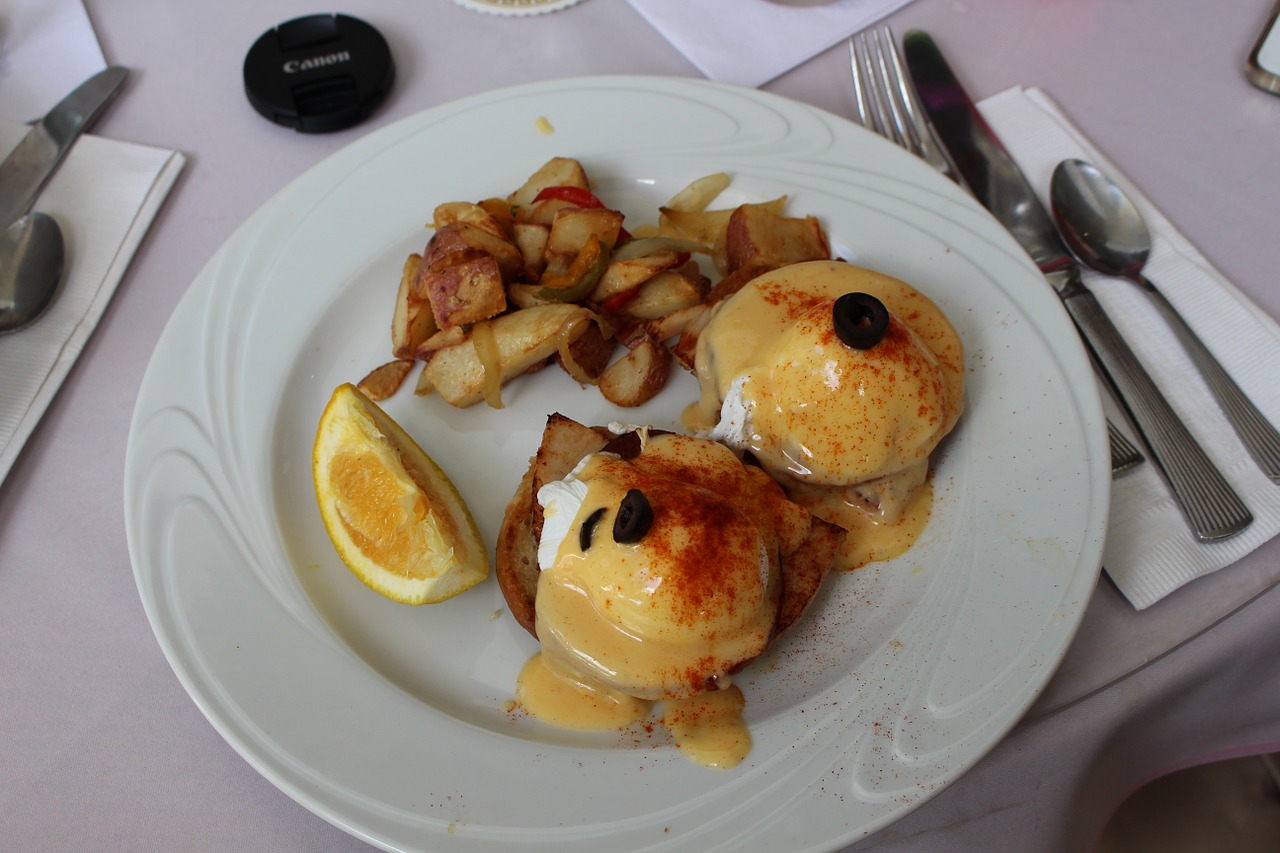In the movie Runaway Bride, Julia Roberts’ character realizes that she has “liked” her eggs however her fiance-at-the-time liked them. In one fantastic scene she makes every type of egg there is to determine what her true preference is.
The verdict? “I love eggs Benedict. I hate every other kind.”
That may be taking it a bit too far, but I do absolutely adore eggs Benedict. Next to the Reuben sandwich, I would say it’s actually my favorite meal of all time.
When I started this blog, I did quite a few brief restaurant reviews. After reading Will Write for Food and taking Steve Barnes’ food writing class, I decided that restaurant reviewing was not for me.
However, before I navigated away from that type of food writing, I did cover eggs Benedict at various diners several times, I believe more than I covered any other one food item when out to eat. I find it so perfect, that I have yet to attempt making the meal myself, for fear of ruining it.
Moving along, let’s check out what exactly eggs Benedict is, and where it came from.
Definition: a dish consisting of toast or toasted halves of English muffin covered with a thin slice of fried or broiled ham, poached eggs, and a topping of hollandaise sauce.
Although it doesn’t specify it in the definition, eggs Benedict traditionally uses Canadian bacon, which we’ve explored a little bit in this blog – it is more ham-like than bacon-like.
Although culinary historians continue to disagree on who invented eggs Benedict, the possibilities are clear: there are four people who may have created this amazing dish, and two who are credited with enhancing and popularizing it.
Three out of the four possible inventors of the dish are all New Yorkers and all have Benedict names; none of them, however, are Benedict Arnold.
The first person who may have come up with eggs Benedict is Lemuel Benedict, a reportedly eccentric and drunken Wall Street stockbroker in the late 19th century. He was known for his “coonskin coat and hollow cane concealing a booze-filled flask.”
Early one morning in 1894, after partying all night, L. Benedict found himself at the Waldorf Hotel. He apparently created his own hangover meal from what he ordered: two poached eggs, bacon, toast, and a pitcher of hollandaise sauce.
Decades later, The New Yorker published a piece in 1942 crediting L. Benedict as the creator of eggs Benedict.
The second person to lay claim to eggs Benedict is Commodore E. C. Benedict, who lived during the late 1800s and early 1900s. Although, to be precise, he himself did not declare he was the creator.
A man by the name of Edward P. Montgomery wrote a letter to the New York Times food editor Craig Claiborne in 1967; Montgomery insisted that his uncle was a close friend of the commodore, and E. C. Benedict was the one to come up with eggs Benedict. Montgomery sent the recipe in with the correspondence.
After Claiborne published the Times piece announcing E. C. Benedict as the inventor of eggs Benedict, Mabel C. Butler of Vineyard Haven, Massachusetts, hurried to write in with the “true story:”
A relative of Butler named Mrs. LeGrand Benedict was a regular along with her husband at Delmonico’s restaurant in New York City during the 1890s. Having tried everything on the menu, Mrs. Benedict asked Chef Ranhofer for poached eggs on English muffins with ham, hollandaise sauce, and a truffle.
In fact, one of the men responsible for introducing eggs Benedict to the world was Chef Ranhofer of Delmonico’s; he also popularized baked Alaska.
The other chef credited with giving eggs Benedict its popularity boost is Oscar Schirky of the Waldorf Hotel; he was the one working when a boozed out Lemuel Benedict came in and proceeded to create the dish.
The fourth possibility of the inventor of eggs Benedict does not bare the name Benedict. In Elizabeth David’s French Provincial Cooking, she highlights a French dish called oeufs bénédictine.
Photo credit: Impossibility.Wordpress.com
The recipe included a “brandade (a puree of refreshed salt cod and potatoes), spread on triangles of French bread. A poached egg is then set on top and napped with hollandaise.”
HistoryAndWomen.com explains that if David did create the dish, this would explain why it has a French name, with the adjective following rather than preceding the noun. Admittedly, it is not clear how this dish could have gotten to America, where its beloved status soared.
Along with Bloody Marys, eggs Benedict is considered to be an excellent hangover food, and is still wildly popular today.
In my own personal opinion, I believe the first contestant is the winner: Lemuel Benedict, the drunken broker. After all, The New Yorker and the Smithsonian Magazine, both highly reputable publications, site Lemuel Benedict as our guy.
Although I am generally a big believer in not altering a classic dish, admittedly there are a lot of fun variations to eggs Benedict. Here are just some of them:
In place of poached eggs you can use:
- Scrambled or baked eggs (easier for feeding a crowd)
In place of Canadian bacon you can use:
- Spinach or avocado
- Prosciutto, bacon, or sausage
- Crab cakes or smoked salmon
In place of hollandaise sauce you can use:
- Tomato sauce
- Cheese sauce
- Chipotle sauce or salsa
In place of English muffins you can use:
- Rye toast
- French toast
- Cornbread
- Biscuits
Have fun with it!

Comments
2 responses to “Food history: eggs Benedict”
Looooove eggs Benedict Yum!
Love eggs this way. Delicious.